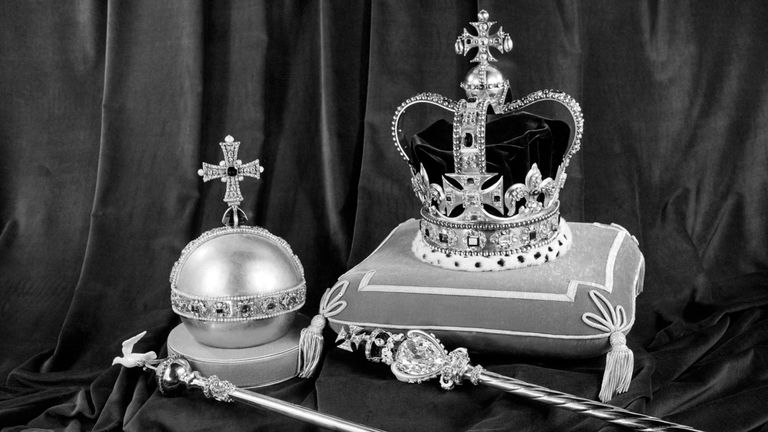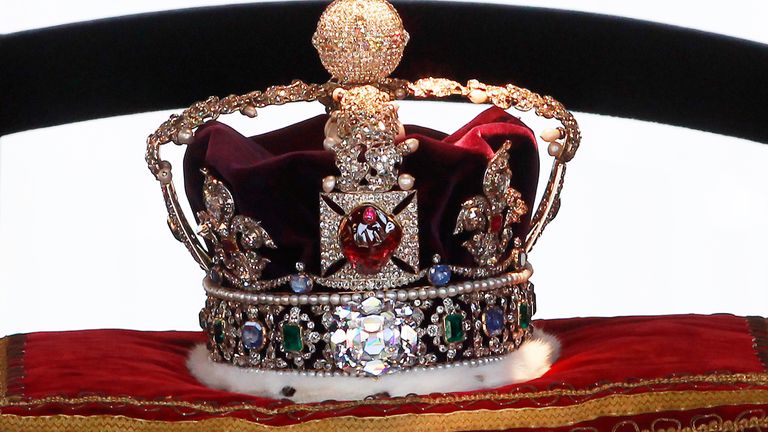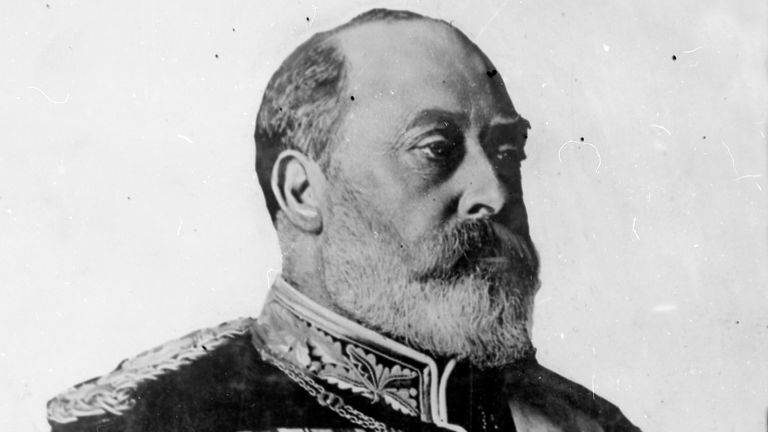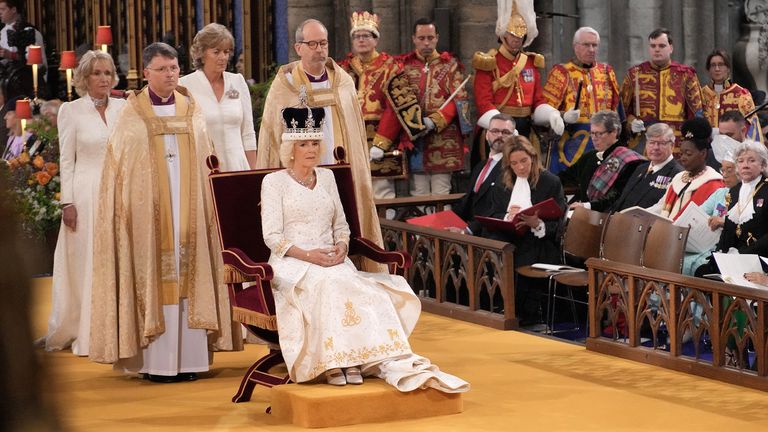King's coronation: Why are the Crown Jewels so controversial?
Known as one of the largest diamonds ever to be found, the Cullinan stone will be in the spotlight during the grand coronation ceremony - where a cut of it will replace the controversial Koh-i-noor diamond.
Saturday 6 May 2023 14:50, UK
The Crown Jewels have been protected at the Tower of London since the 1660s, but their history remains controversial.
Known as the nation's treasures, the Crown Jewels consist of over 100 items and over 23,000 gemstones, the Historic Royal Palaces website says.
A significant part of the Royal Collection, the Crown Jewels includes items such as orbs, sceptres and crowns - some of which the King and Queen held and wore during the coronation at Westminster Abbey.
The Cullinan diamond - the largest diamond ever found - is just one of the many diamonds that will be in the spotlight during the coronation ceremony.
It again entered the public eye when cuts of the original diamond sat atop the royal sceptre and in Queen Camilla's crown, where it was substituted for the even more controversial diamond, the Koh-i-noor.
Here's a look back at its history - and why those two jewels, in particular, are so controversial.
Who was Thomas Cullinan?
Thomas Cullinan, a businessman who worked in South Africa, is known for giving his name to the largest diamond ever discovered in the country.
He moved to Johannesburg in 1887, where he first became a bricklayer and after earning some money, he found an interest in sales and business.
In 1897, Cullinan moved to Parktown, where he discovered the Premier diamond fields a year later.
Cullinan soon became the co-founder of what came to be The Transvaal Chamber of Industries - a mining-industry employer organisation.
He continued to grow in his career and in 1910, Cullinan was knighted for his work in the diamond industry.
How did the diamond end up in the UK?
According to the Cape Town Diamond Museum, the diamond was first discovered at the Premier Mine in Pretoria, South Africa, by Fedrick Wells in 1905.
The Cullinan diamond was only a fragment of an even bigger stone that was still not yet discovered - it weighed 3,106 carats (621.2 grams).
The stone was carefully sent off to England and to keep it safe, detectives from London were asked to send out replicas and decoys in public to throw off potential thieves.
After the Anglo-Boer War, the South African Transvaal government bought the diamond from Cullinan and later presented and gifted it to Britain's King Edward VII in 1907.
What are Cullinan I and Cullinan II?
The diamond was then entrusted to what is now known as The Royal Asscher Diamond Company.
King Edward VII invited the Asscher brothers to London to discuss cutting the diamond into different pieces.
The original diamond was "the size of a human heart", the Royal Asscher website says.
After months of careful planning and studying, it was decided that Joseph Asscher who founded the company would cleave the Cullinan into nine major stones and 96 smaller stones.
There were two diamonds amongst those that weighed the most.
These were known as the Cullinan I and Cullinan II.
Cullinan I became known as the Star of Africa and Cullinan II became known as The Lesser Star of Africa.
In 1910, after King Edward's death, King George V had the Cullinan I and Cullinan II set in the sovereign's sceptre and Imperial State Crown respectively.
The 96 smaller stones were given to the Asschers as their fee for cutting the diamond.
'The diamond's gift in 1907 was controversial'
As the royals prepare their Crown Jewels for the upcoming ceremony, the question of right and wrong surrounds them - with growing calls for the royals to return the cuts of the diamond to their homeland.
Dr Matt Graham, a senior lecturer in African history at the University of Dundee, said: "The journey of this diamond [The Cullinan] from South Africa to the monarchy is part of imperial networks, empire, and colonial rule, where resources from across the world were extracted for the benefit of Britain.
"There are demands within South Africa for reparations and the return of the gem because it is a powerful symbol of empire."
After the death of Queen Elizabeth II, both the Cullinan I and II were placed on display.
While the late Queen was laid to rest, criticism arose of the late monarch for never formally apologising for Britain's colonial past in South Africa.
And so, the Cullinan diamond remains wrapped in the timeline of colonial history, which raises the question of whether the cuts of it should return to the land where the original stone was found.
Last year, activists in South Africa also petitioned for the cuts to be returned and placed in a South African museum instead.
Professor Saul Dubow from the faculty of history at the University of Cambridge told Sky News the Cullinan diamond was controversial, but it also played a role in the dispute within "white politics".
He said: "The diamond's gift in 1907 was controversial, but it was principally a matter of dispute within white politics, specifically, about the gift as a gesture to win the support of the Crown and British Liberal opinion in the aftermath of the Boer War."
Professor Dubow said the hope at the time was that "this would facilitate reconciliation between English and Dutch-speakers. Further Cullinan stones were gifted to Queen Mary by the new South African government of Louis Botha and Jan Smuts - both of whom had fought against British imperialism - on the achievement of independence from Britain in 1910."
He continued: "Political union was indeed achieved at the cost of black South Africans. But it is hard to see a direct connection between the gift of the diamond and the loss of African rights.
"Some campaigners are now arguing that the diamond should be restored to Africa because it came out of African soil and that the colonial government had no right to give it away in the first place.
"The crown's designation of the Cullinan as the 'Great Star of Africa' may thus be an unintentional hostage to fortune!"
What is the Koh-i-noor diamond and why is it controversial?
Earlier this year, Buckingham Palace released a statement confirming the Koh-i-noor diamond would not be worn by the Queen Consort.
The East India Company seized the historic treasure in 1849 when it was presented to Queen Victoria and became part of the Crown Jewels.
The Koh-i-noor diamond, also known as "Mountains of Light" in Persian, has also been the centre of controversy over the years with political and legal disputes regarding its original owner.
In 2016 the All India Human Rights and Social Justice Front, a non-governmental organisation, filed a lawsuit seeking its return.
However, Solicitor General Ranjit Kumar told India's Supreme Court in New Delhi it was given to Queen Victoria in 1850 by a 19th-century Sikh king.
"It was given voluntarily by Ranjit Singh to the British as compensation for help in the Sikh Wars. The Koh-i-noor is not a stolen object," he said.
Be the first to get Breaking News
Install the Sky News app for free


But the debate of ownership and its painful past continues to this day.
A spokesman for Indian Prime Minister Narendra Modi's Bharatiya Janata Party reportedly said last year - before the decision was made to remove it: "The coronation of Camilla and the use of the crown jewel Koh-i-noor brings back painful memories of the colonial past.
"Most Indians have very little memory of the oppressive past. Five to six generations of Indians suffered under multiple foreign rules for over five centuries.
"Recent occasions, like Queen Elizabeth II's death, the coronation of the new Queen Camilla and the use of the Koh-i-noor does transport a few Indians back to the days of the British Empire in India," he added.
The King's Coronation
Queen Camilla was crowned with Queen Mary's Crown - reset with cuts of the Cullinan diamond - which was originally commissioned for the coronation of Mary of Teck as Queen Consort at the coronation of King George V in 1911.
The King was crowned with the St Edward's Crown, a solid gold crown set with precious stones. The crown weighs 2.23kg (nearly 5 lbs).
The grand event will be celebrated on Saturday 6 May 2023, across the weekend, with 2,000 guests set to attend the ceremony at Westminster Abbey.
There will also be processions, a concert, and nationwide lunches to commemorate the historic crowning ceremony.
To find out more about what's happening across the weekend - you can see full details here.







